


|
Eastern Tibesti, Chad, February, 202-
|
The rock art sites of Karnasahi, Korossom and Fofoda on the Ouri plain along the Eastern side of the tibesti mountains rank among the most important in the Sahara, yet they have only been visited by a handful of people in the past 50 years (despite their discovery already in the nineteen thirties). The paintings depict mainly cattle and human figures in a very refined style. They have been inaccessible for the best part of the past 15 years, however there is now a window of opportunity. In January 2015 and January 2017 we made an initial exploration of the area, establishing the access routes, visiting the most important sites, and already making some new discoveries. On this planned expedition we will hope to take the Eastern route (from Faya via Gouro), and with the gained time visit some more Northerly sites (Araské, Ouri Sao, Riparo del Mani, if possible Mossei), some trekking may be required, depending on the information we will have from our quide on the safe routes for vehicles. We will also allocate some days to survey several areas that were not explored by the Italian parties in the nineteen nineties. Like on the past trips, ground logistics will be provided by S.V.S..
There is very little published material available on these sites, which were discovered by Francois d'Alverny, a French officer in the period 1934-1936. Alverny's notes were only published posthumously in 1950, and the sites had to be re-discovered in 1993-94 by the expeditions of Adriana Ravenna, Sergio Scarpa Falce, Aldo & Donatella Boccazzi. The finds have been published in the Cahiers de l'AARS and Sahara. d'Alverny's 1950 account and the Cahiers articles are available online as pdf files:
Francois d'ALVERNY (1950), Vestiges d'art rupestre au Tibesti oriental, Journal de la Société des Africanistes, Vol. 20, No. 2, pp: 239-272
Adriana RAVENNA, Sergio SCARPA FALCE, Donatella e Aldo BOCCAZZI (1996), Le pitture della conca di Ouri e dell'enneri Korossom (Tibesti orientale ), Cahiers de l'AARS, No. 3.
Adriana RAVENNA, Sergio SCARPA FALCE, Donatella e Aldo BOCCAZZI (1998), Le pitture del Tibesti orientale, Cahiers de l'AARS, No. 4.
Since Issue 6 (1994) an article was published almost every year by Adriana Ravenna, Sergio Scarpa Falce, Aldo & Donatella Boccazzi in Sahara on individual shelters, the observed styles and the relative chronology of the rock art of the Ouri region.
To receive a "feel" of the trip style and what to be expected along the way and at the Ouri plain, please have a look at the January 2015 and January 2017 trip accounts. Click here to download Google Earth file (kmz) with waypoints of places mentioned below, to be able to fllow the planned route.
Day 0. – Arrival to N’Djamena
Based on past experience, the flights options are limited to Turkish Airlines (via Istambul) and Air France (via Paris CDG) from almost everywhere. Both arrive to N’Djamena in the late evening. We will spend one night in N’Djamena a the Ibis Hotel.
Days 1-3. – N’Djamena - Faya
All paperwork should be completed in the morning, we should be able to depart at around 10am all things going well. We will spend 3 days driving up North along the rather dull and dusty Bahr el Ghazal, then across the Bodélé desert and the Erg Djourab, camping at suitable spots wherever nightfall nears.
Day 4-6. – Faya to Ouri Plain via Gouro
Provided all things go to plan, we should be able to reach the Ouri Plain from Fada in two days, but invariably there are likely to be delays in Guro, even if the arrangements with the guide are pre-arranged. Three days are planned, but one must be prepared for more (still better than the six days needed via Yebbi Bou).
Day 7-8. - Karnasahi area
We will spend two nights at the Karnasahi camp, visiting the principal site in different lighting conditions, and make excursions to other sites within a 10 kilometre radius, including the major double shelter of Tcherughé about 8.5 kms to the South east. There are also large unexplored areas along the Eastern side of the Ouri plain, some of which we will atempt to survey on foot.

|
KARNASAHI This is one of the orignal sites discovered by d'Alverny in November 1935, and the name was used by Paul Huard to name the peculiar style of paintings found in the entire Ouri region, of which the Karnasahi shelter contains some of the best examples. |
|
The Karnasahi painntings are executed in a very elegant and refined style, with much attention given to the details.of the human figures. The humans are accompanied by similarly well executed cattle, clearly incicating a pastoral society. The quality of paintings rank the Karnasahi style among the finest cattle pastoralist paintings in the sahara, alongside those at Iheren & Sefar in the Tassili and the ones at Jebel Uweinat. The actual Karnasahi shelter only contains relatively few figures, but of an excellent quality. There are several other shelters nearby with the same style of paintings, including the double shelter at Tcherughé which contains a unique milking scene, something surprisingly rare among Saharan pastoralist paintings. |
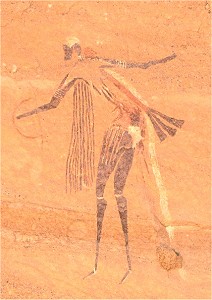 |
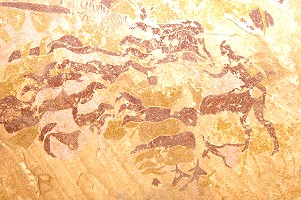 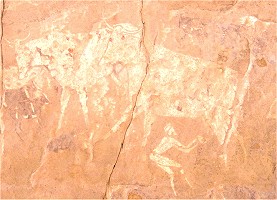 |
Day 9. - Enneri Korossom
This will ba a day's excursion along the Enneri Korossom to a number of fine sites around Korossom Timmy. We will drive up the Enneri Korossom to e farthest accessible point, and walk from there.
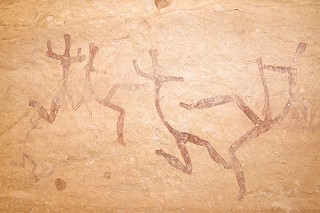
|
KOROSSOM In 1949 a major site was found by Capitaine Schleibing along the Enneri Korossom (leading up to the village of Aozi). It was named Korossom Timmy after the solitary palm tree (in Teda language "timmy") nearby. It contains a series of human figures from a hunter society that pre-date the more common catte pastoralist scenes, which d'Alverny already noted at Fofoda. |
|
In the vicinity a number of other shelters were discovered in the nineties, some containing many more of these figures, accompanied by a number of strange quadriped animals with a very indistinct head, characteristic of these type of paintings, named "Korossom fantastic" by Ravenna & Boccazzi. They represent the earliest period of paintings in the area. Other shelters in the area contain many Karnasahi style paintings, and a unique scene with several extremely finely and delicately drawn camels with associated humans, one of the finest known paintings from the camel period in the entire Sahara (in stark contrast to the usually crude execution observed elsewhere). |
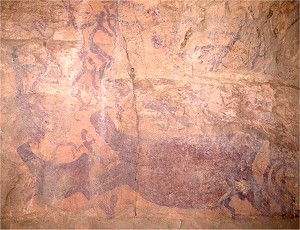 |
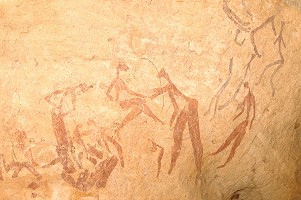 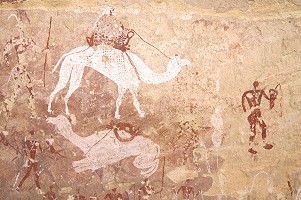 |
Day 10-11. - Fofoda
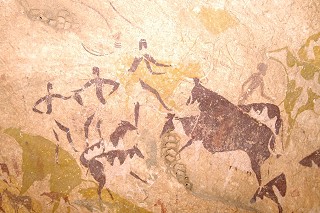
|
FOFODA The shelter of Fofoda was discovered by d'Alverny in October 1934, and it was this site that propted him to begin surveying the area for more rock art sites over the subsequent two years. The shelter contains some very fine groups of cattle and humans in the Karnasahi style, and contrary to many sites in the area it is in an excellent state of preservation. |
|
In 1997 a major new discovery was made by Aldo & Donatella Boccazzi, with hundreds of human and cattle figures in the finest Karnasahi style on an exposed vertical rock face a few kilometres from the original site noted by d'Alverny. There are several more lesser sites in the immediate area. |
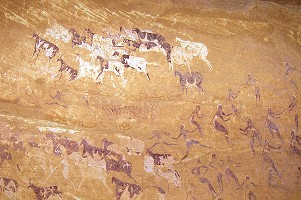 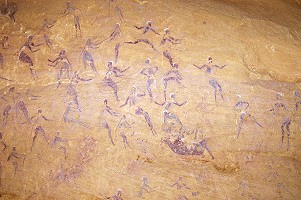 |
Day 12. - Enneri Borbore – Ennedi Borou
These two valleys are 5-10 kms to the North of Fofoda, and both have a wealth of sites. We will see a selection of highlights, including site BS (Sorou South) 2, which is one of the largest sites on the Ouri plain, with paintings from all periods.
Day 13-14. – Northern part of the Ouri plain
This will be unvisited territory, the exact places we may visit will much depend on our guide. The Enneri Araské is certainly within safe limits, however the area around and to the North of Ouri were heavily mined in places.
Day 15. - Reserve day
With all sorts of possible delays along the way, a reserve day needs to be planned to recover any lost time and still make it to N'Djamena on time. If by some miracle we would still have this day available, we may spend it to see some more unexplored areas on the Our Plain. This may be decided once we have comfortably reached the plain and our water reserves are sufficient (or we found water in one of the gueltas).
Day 16-17. - Return via Gouro to Fada
A 2 day drive back to Fada along the same route we have taken via Gouro.
Day 18-20. - Faya – N’Djamena
Another 3 day drive back to N’Djamena. With flights leaving late in the night, we will have 2 day-rooms at the Ibis hotel so we can all take a proper shower and change into a more civilized appearance before boarding the flight.
For information on expected costs, planned dates and any further questions, please send me an email.
Back to planned expeditions...